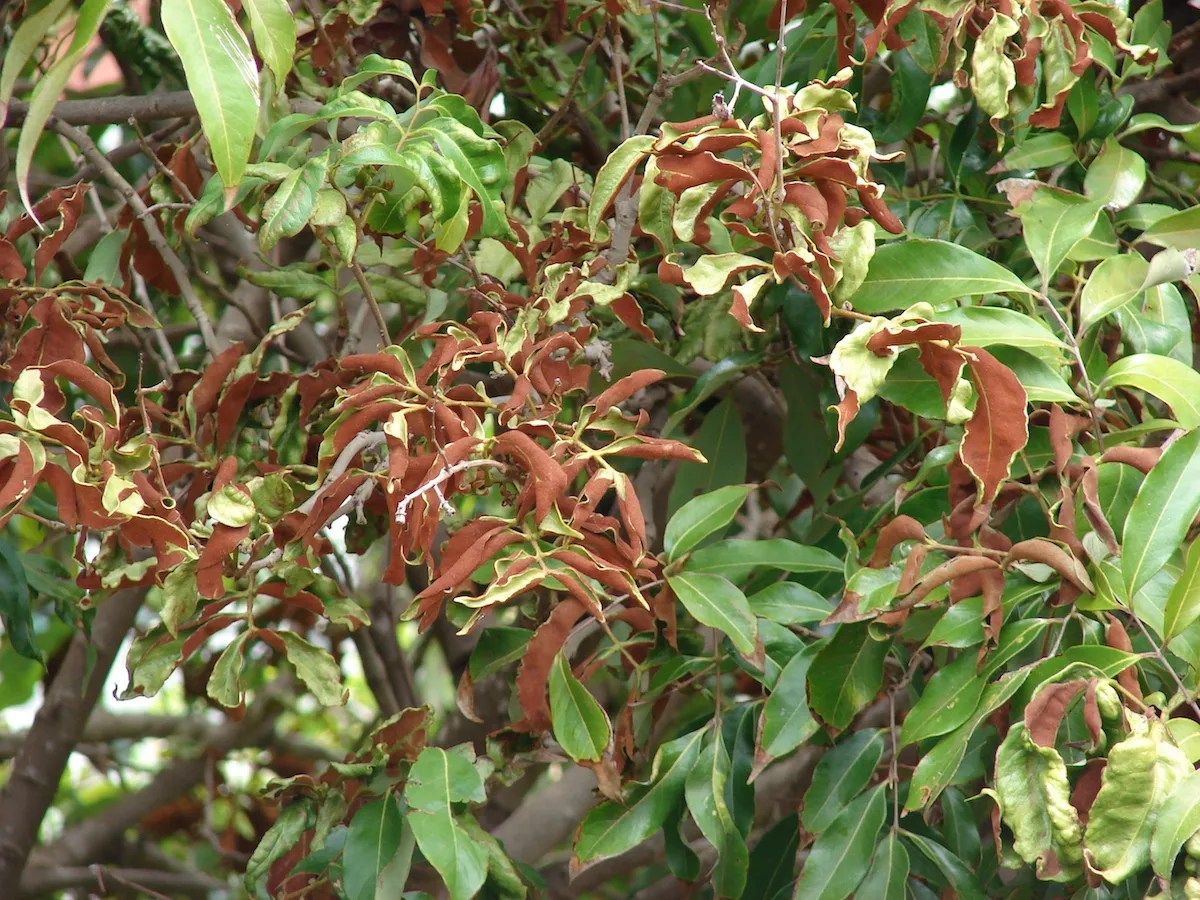
Wikimedia Commons/Starr Environmental

Audio By Carbonatix
Researchers, agriculture officials, and growers are asking anyone and everyone with a lychee tree – whether one or several acres of them – to look for signs of Aceria litchii, known as the lychee erinose mite, after a tree was found infested in a North Miami homeowner’s yard last month.
The tiny mites, which originated in Asia, are so small their chubby sectioned bodies can be fully seen only under an electron microscope. This isn’t the first time they’ve appeared in Florida over the past century, though, but when they were found on Lee County’s lychee trees in early 2018, the state enacted a quarantine and ordered the area’s growers to refrain from distributing the fruit.
“They can [move around] pretty easily – they can be on your clothes, they can be on your tools, and honeybees can move them around,” says Jeff Wasielewski, a tropical fruit expert who works for the University of Florida and Miami-Dade County.
The mites prefer to latch onto trees’ tender new growth and build a kind of protective shell that makes them difficult to remove or kill. Eventually, small depressions begin to form on the leaves, and the mites irritate them to begin producing a white fuzz. The mites lay their eggs in that fuzz, and as the tree becomes increasingly irritated, it starts producing a scrubby, rust-colored veneer. The mites will also attack lychee blossoms and fruit.
Miami, make your New Year’s Resolution Count!
We’re $14,500 away from reaching our $30,000 year-end fundraising goal. Your support could be what pushes us over the top. If our work has kept you informed, helped you understand a complex issue, or better connected you to your community, please consider making a contribution today.
The mites are so easily transmitted that Wasielewski says people who find them shouldn’t attempt to do any maintenance.
Instead, he encourages people to contact the Florida Department of Agricultural and Consumer Services Division of Plant Industry at 888-397-1517.
The department is forming a plan to eradicate the mites.
“We’ve been strategizing and working on eradication since we first identified the pest in 2018,” says Christina Chitty, public information director for the department’s Division of Plant Industry. “We’ve successfully eradicated the pest twice in Florida, once in 1958 in Sarasota County and once in 1993 in Miami-Dade County, using the methods we’re going to use this time: sulfur miticide and tree trimming.”
The concern over the spread of the mites to South Florida is twofold. First, it’s the largest lychee-producing region in the nation, with approximately 1,200 acres of the trees, according to the University of Florida. Second is that lychees are delicious, precious, and beautiful. For those who didn’t grow up here, the first bite of lychee that didn’t come from a can is like a communion with Mother Nature. Seeing the translucent white flesh emerge from a bright-red skin is baffling and nothing compared to the juicy, slightly rosy flavor of the fresh fruit. Their allure is compounded by the fact that fresh ones are available only six weeks of the year.
“They’re special,” says Louise King, whose Royal Grove Farm in the Redland tends about three acres of lychee trees plus an acre of sapodilla, mango, and carambola. “It could be an economic loss, but as farmers, we love these trees; we care for them.”
King began growing lychees in the early 1990s and enjoyed the benefit that Florida, thanks to its tropical climate, was the leading lychee-producing region, ahead of even Hawaii and California. The fruit became less lucrative after a series of trade deals in the late 1990s flooded the market with cheaper foreign lychees, yet in her experience, Kings says, an acre can produce, on average, about 8,000 pounds of fruit.
At the moment, growers such as King, who also heads the Tropical Fruit Growers of South Florida, are waiting for more research from the University of Florida and the state while also encouraging homeowners with lychee trees to check them if their livelihoods depended on it.
“It might seem to only affect your tree, but it could be devastating to the industry,” King says. “Thankfully, a homeowner with one lychee tree in their yard noticed something wrong and was paying attention even when there wasn’t fruit, and they were concerned enough to call Miami-Dade County Agricultural Extension and say something was wrong, and because of that, this whole alert system is now engaged.”
Correction published March 5, 2020: As originally published, this story misstated the official name of the Florida Department of Agricultural and Consumer Services and misspelled the name of Division of Plant Industry public information director Christina Chitty. Additionally, Chitty says the lychee erinose mite is incapable of flight. The above version of the story reflects the corrected text.